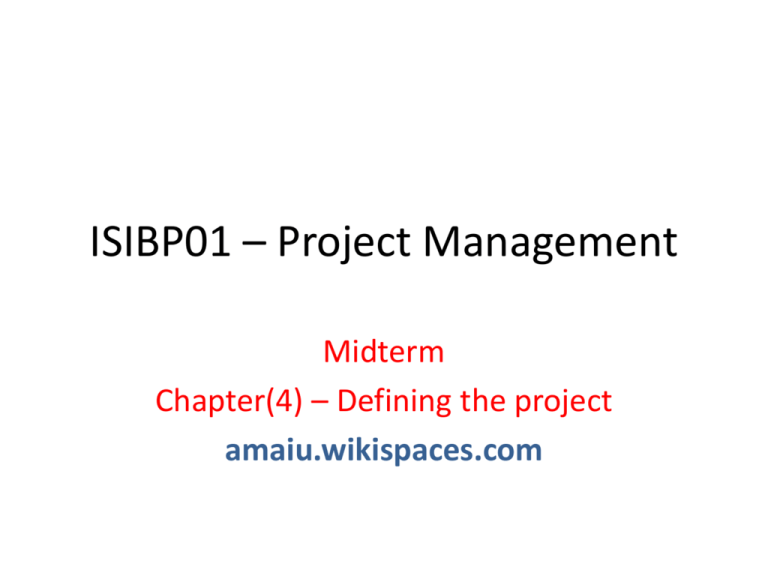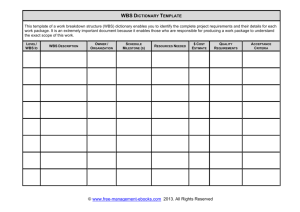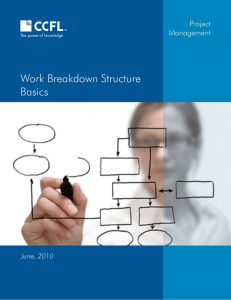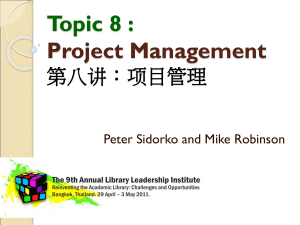ISIBP01 * Project Management - amaiu
advertisement

ISIBP01 – Project Management Midterm Chapter(4) – Defining the project amaiu.wikispaces.com WBS Vs. PBS • WBS (Work Breakdown Structure): it is the method suggested for selecting outline of the project. • PBS (Process Breakdown Structure): it is matrix of responsibilities which are used for design and build projects. • Assignment due date: Thursday 21/11/2013 Developing WBS • The five general steps to provide a structure approach for collecting the project information for developing a work breakdown structure: 1. Defining the project scope 2. Establishing project priorities 3. Creating the work breakdown structure 4. Integrating the WBS with the organization 5. coding the WBS for the information system Step 1: Defining the project scope • It is the definition of the end result or mission of the project- a product or service for the client/customer. • Directs focus on the project purpose throughout the life of the project for the customer and project participants. • Scope describes what can expect to deliver to the customer when the project is complete. • Scope should define the results to be achieved in specific, tangible and measurable terms. • Project scope is a document that will be published and used by the project owner and project participants for planning and measuring project success. • Project scope must be as brief as possible but complete. Project Scope Checklist • It is used as steps to ensure that scope definition is complete. 1. Project objective: define a project overall steps to meet customer’s needs within specific time and within a specific cost. 2. Deliverables: the expected outputs over the life of the project as design phase, software coding and technical manual and test prototype. 3. Milestones: is a significant event in a project that occurs at a point in time. It shows only major segments of work. Project Scope Checklist 4. 5. 6. Technical requirements: It is important to ensure proper performance as the required voltage for Computer must be 240 Volts as to be accepted. Additional for that, speed and capacity. Limits and exclusions: Limits the scope will save the project to avoid false expectations and expending resources and time as an example, system maintenance and repair will be done only up to one month after final inspection. Exclusions also define the boundary of the project by stating what is not included as an example, house will be built but no land spacing or security devices added. Reviews with customer: it is to understand agreement of expectations as if the customers getting his desires in deliverables then review if the project definition is done as accomplishments, budgets, and timing and performance (scope) requirements and if project’s limitation and exclusion is covered. Milestones characteristics 1. It represents Estimates of time, cost and resources for the project. 2. It is built using the deliverables as a platform to identify major segments of work and an end date. 3. Should be natural, important control points in the project. 4. Should be easy for all project participants to recognize. Step 2: Establishing project priorities • Establishing project priorities : can be done through two techniques: 1. Project management trade-offs: • Project managers have to discuss the importance of each criterion (Scope, Cost and Time) with the project customer and upper management to establish the relative importance of each of them. • Because the longer a project takes, the more expensive it becomes; a +ve correlation between cost and schedule may not always be true; the cheaper equipment used with less efficient labor may extend the duration of the project. Establishing project priorities Establishing project priorities 2. Project Priority Matrix: by identifying which criterion (scope, cost or time) is constrained, or should be enhanced and which can be accepted? • It is useful midway in the project for approaching a problem that must be solved. • It’s decision must be developed for a project before the project begins by sharing expectations with customers and top management to avoid misunderstandings. Establishing project priorities • There are three choices in this technique: a) Constrain: the original parameter is fixed that the project must meet the completion date, specifications and scope of the project or budget. b) Enhance: Given the scope of the project, which criterion should be optimized? In case of time and cost that mean to take opportunities to either shorten the schedule or reduce the cost then in case of performance means, adding value to the project. c) Accept: which criterion is it tolerable not to meet the original parameters? Is that will go over budget? Establishing project priorities Step 3: Creating the work breakdown structure • • • 1. 2. 3. 4. 5. WBS (Work breakdown Structure): It is a map or an outline of the project with different levels of detail. Purpose of WBS: it helps to assure project managers that all products and work elements are identified, to integrate the project with the current organization and to establish a basis for control. How WBS helps Project Manager? It defines all the elements of the project in a hierarchical framework and establishes their relationships to the project end items. So the large work package is broken down into smaller work packages that the total project is the summation of all the smaller work packages. WBS facilitates evaluation of cost, time and technical performance at all levels in the organization over the life of the project. Each item in the WBS needs a time and cost estimate. Also problems can be quickly addressed and coordinated because the structure integrates work and responsibility. WBS provides the opportunity to “roll up” (Sum) the budget and actual costs of the smaller work packages into larger work elements so the performance can be measured by organizational units and work accomplishment. Step 3: Creating the work breakdown structure Step 3: Creating the work breakdown structure Step 3: Creating the work breakdown structure Step 3: Creating the work breakdown structure • Level 1: Represents the total project objective and it is useful to top management. • Level 2, 3 and 4: shows the partial list of a deliverables necessary to develop the personal computer as disk storage unit which is made up of three sub- deliverables that are external USB, optical and hard disks. Finally, hard disks require four sub- deliverables that are motor, circuit board, chassis frame and read/write head. That is suitable for middle management. • Level 5: represents the lowest manageable level of subdeliverables that is controlled by first-line managers. Step 3: Creating the work breakdown structure • Work packages: is the lowest level of the WBS. They are short-duration tasks that have a definite start and stop point, consume resources and represent cost. A work packages manager is responsible for seeing that the package is completed on time, within budget, and according to technical specifications. • Practice suggests a work package should not exceed 10 workdays or one reporting period. Step 4: Integrating the WBS with the organization • WBS is used to link organizational units responsible for performing the work. • So OBS (Organization Breakdown Structure) provides a framework to summarize organization unit work performance through sub-deliverables patterns in smaller and smaller units. • OBS assigns the lowest organizational unit the responsibility for work packages within a cost account. Step 4: Integrating the WBS with the organization • Cost account: it is a project control point which a result of intersection of work packages and organizational unit. It integrates work and responsibility. • Cost account is the focal point because all budgets, work assignments, time, cost, and technical performance come together at this point. Step 4: Integrating the WBS with the organization Step 5: coding the WBS for the information system: • The codes are used to define levels and elements in the WBS, organization elements, work packages and budget and cost information for gaining the maximum useful of a breakdown structure. • Process Breakdown Structures (PBS): Which the final outcome is a product of a series of steps or phases. Step 5: coding the WBS for the information system: Responsibility Matrices (RM) or Linear Responsibility Chart • It summarizes the tasks to be accomplished and who is responsible for what on a project. • In its simplest form an RM consists of a chart listing all the project activities and participants responsible for each activity. • It is useful for small projects and subprojects of large and more complex projects. • More complex RMs clarifies critical interfaces between units and individual require coordination. Responsibility Matrices (RM) or Linear Responsibility Chart Responsibility Matrices (RM) or Linear Responsibility Chart Project Communication Plan • It is usually created by the project manager and/ or the project team in the early stage of the project planning. • It’s out the flow of information to different stakeholders (project manager, sponsor, project team, project office customer) • It becomes an integral part of overall project plan. • It is important in coordinating, project schedules, issues, and action items. Purpose of Project Communication Plan • The main purpose is controlling the flow of information by expressing what, who, how and when information will be transmitted to project stakeholders. • So schedules, issues, and action items can be tracked. Steps of developing a Communication plan: 1. Stakeholder analysis: identify the target groups who needs project information to make decisions and /or contribute to project progress. 2. Information needs: what information is needed to stakeholders to know as milestone reports, team status meetings, accepted request changes, action items, gating decisions and project status reports. 3. Sources of information: Where does the information reside? How will be collected? It’s would be found in minutes and reports of various groups. Steps of developing a Communication plan: 4. Dissemination modes: Normally, Traditional status report meetings are being supplemented by e-mail, lotus notes, SharePoint and different database sharing programs. In particular, others are using the web to create a “virtual project office” to store project information. Project management software feeds information directly to the web site so different people have immediate access to the relevant information. 5. Responsibility and timing: Determine who will send out the information to the appropriate stakeholder. Sometimes responsibility lies with project manager or project officer. WBS Example – Chart Format WBS Example – Outline Format WBS Example – Tabular with cost WBS Question Construct the WBS for the following table using codes and costs







